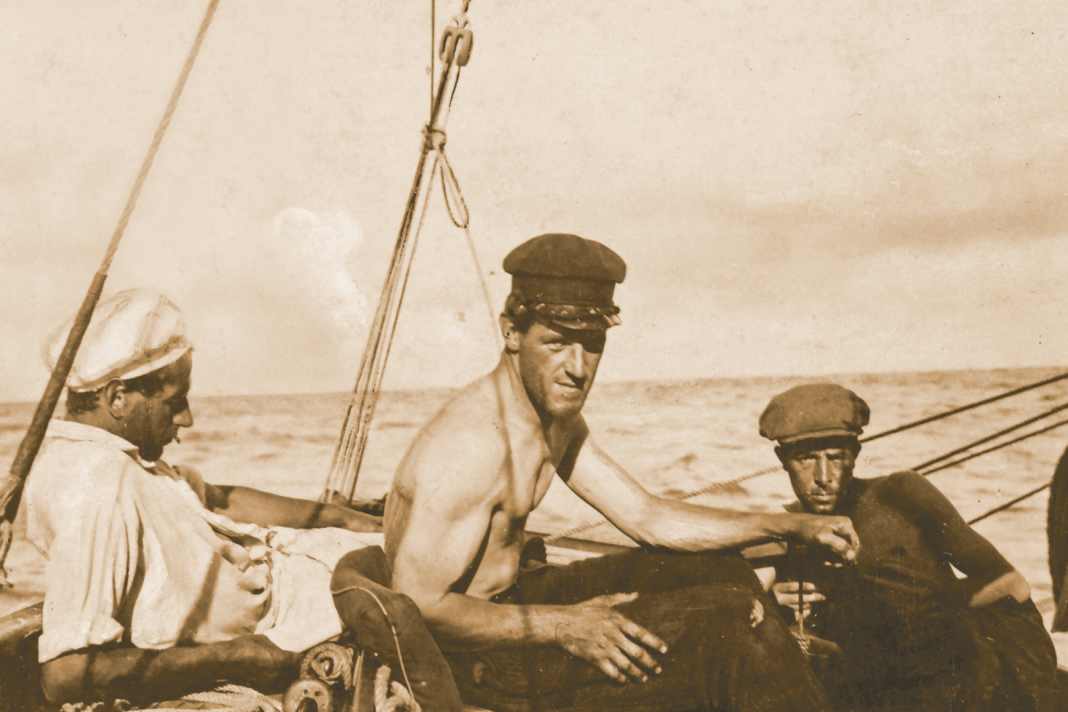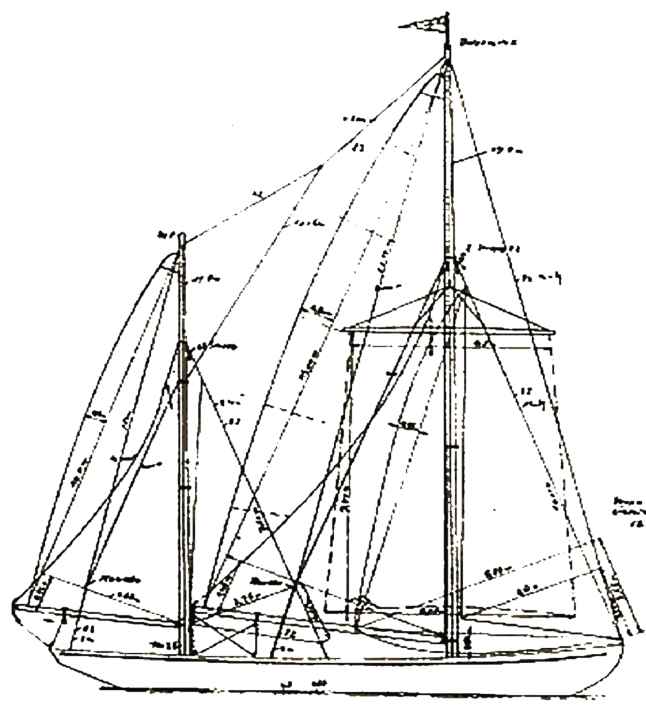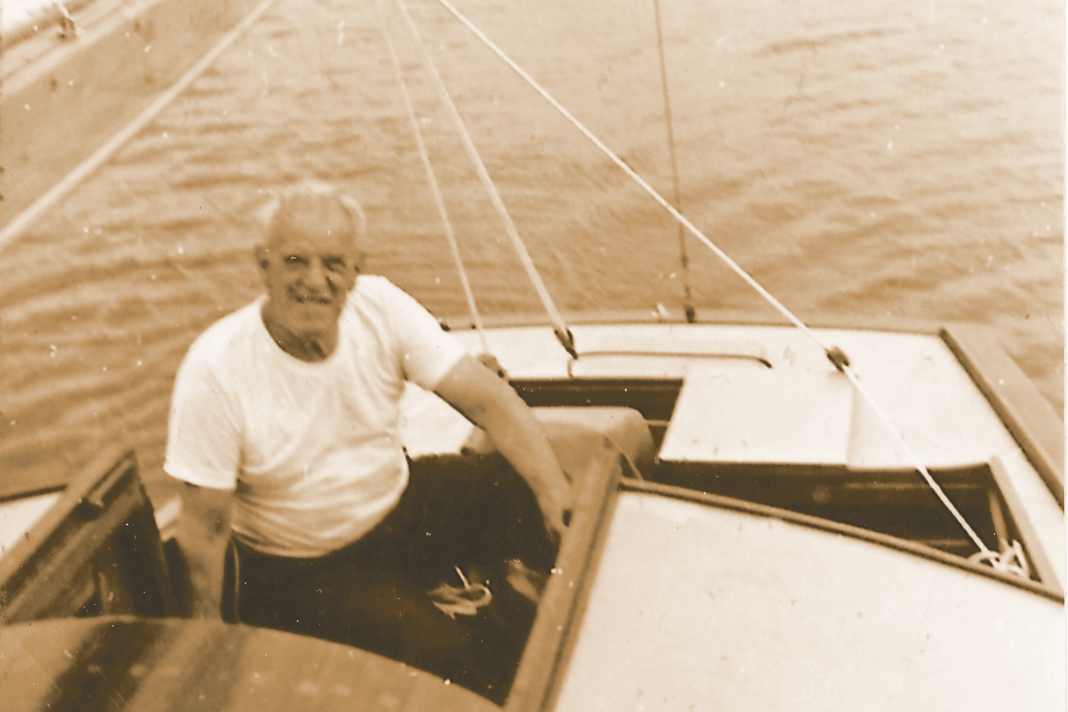History: Designer Plunder sailed across the Atlantic with "Sowitasgoht V" in 1923






- First German/Austrian sponsorship campaign
- 12,000 spectators at the launch of the "Sowitasgoht V"
- Differences of opinion among the crew
- "Ugh, how the sea stinks"
- "Sowitasgoht V" remains largely unscathed
- Parting of the ways in the USA
- Technical data of the "Sowitasgoht V"
- Franz Plunder (1891-1974)
To this day, ocean sailors know a thing or two about it: "Life on board started to become very monotonous because we had all known each other for so long. When one person opened their mouth, the other always knew what was coming." In the middle of the Atlantic, on the way from Madeira to New York, four men were bobbing around on a self-built sea cruiser at the end of August 1923.
Three weeks of sunshine, Atlantic swells, spinnaker shifts more out of boredom than necessity. The ship rolls, thoughts wander: "We knew and felt that people were thinking a lot about us," writes Franz Plunder, a boat builder from Bregenz, later in a report on the trip, "and that perhaps many people were saying 'they've long since been finished'."
More exciting articles from the world of classics:
- 60 square metre national cruiser: "Stromer's" worthwhile rescue
- 12-mR yacht "Princess Svanevit": Historic icon adorns the Stockholm archipelago
- Portrait: Ahead of their time - the Ohlson brothers, yacht designers
- Workshop visit: The Boudalas family is the third generation to manufacture historical model ships
But they are not. The water is running low and the last of the potatoes will be eaten in the next few days. But these are miseries that the less fortunate crew will survive. After all, they are pioneers: Never before have German or Austrian sports sailors crossed the Atlantic together in an east-west direction. On board the Ketsch with its designer Franz Plunder are Josef Einsle, a former captain from Bregenz, and Fred Jochum. Josef Ledergerber, sailing master of the Royal Württemberg Yacht Club in Friedrichshafen, is the German in the four-man crew. They can all sail and navigate, but none of them have any ocean experience. Their 14-metre boat with a reinforced concrete keel and, unusual for the time, no gaff sail, instead rigged high as is normal today, is called "Sowitasgoht V".
This is not Low German, but Vorarlberg dialect for "as far as it goes". The yacht initially claims the name for itself in pecuniary terms, as it turns out to devour money during construction to the point of destitution for its owners.
First German/Austrian sponsorship campaign
Even as they were working on the "Sowitasgoht V" in an unheated boat hall in Hard in the winter of 1922, their finances were proving inadequate in view of the weak economic situation and dwindling due to inflation. Franz Plunder is a successful boat builder and designer and, together with Fred Jochum, owns the shipyard.
The two have a certain level of recognition, even beyond Lake Constance. Using this to finance daring sailing adventures is commonplace today. Not back then. Plunder and Jochum launched what was probably the first sponsorship campaign in German and Austrian sailing history. They take a model of their boat on a lecture and advertising trip to Germany. Fred Jochum spends weeks putting on his tie and collar before hopefully knocking on the doors of various yacht clubs and dealers. Franz Plunder uses his contacts in Hamburg and Berlin and at least manages to arouse some interest there.
Piquant: "This interest is particularly justified by the fact that it is a German vessel and a German crew, who - in contrast to the previous crossings - want to start the journey from Europe this time," an article in YACHT in 1922 summarily invites the ship and crew to Germany - and solicits support for the bold project: "After all, it is also an opportunity to express the unity of the entire German sailing sport and the Austrian sailing sport associated with it all over the world."
Plunder himself does not harbour such German nationalist thoughts. "Many people asked why we were actually doing this trip. I never really knew the answer to that, because what am I supposed to tell people who have no sense of adventure or sport?" Perhaps this is one of the reasons why the final outcome of the promotional trip was rather poor: Fred Jochum returns home with only 45 kilograms of weight and a deficit of 4,000 marks, but at least with a lot of material. Franz Plunder, on the other hand, cannot list all the sponsoring "water sports equipment shops", but thanks them in a multi-part report in YACHT in 1923, "I know that most of them gave in the interests of the cause and not for advertising". Schoolchildren at home in Hard are also curious to see the boat building and make "a huge advert" at home, which leads to their parents wanting to contribute to the company with a little money and provisions.
12,000 spectators at the launch of the "Sowitasgoht V"
The efforts of the promotional tour should only fall away from them once they have left Borkumriff: "How nice it was to be so alone. No more prying eyes and questions, no more lectures and know-it-alls. Dr Oertz once said: 'If you follow all the good advice you're given, you'll put together a wonderful ship, but you'll never finish it'," Franz Plunder noted on the trip. So they put aside a lot of good advice and ignore some of the clever people who predict their certain doom.
A crowd of 12,000 spectators stands at the harbour as the "Sowitasgoht V" is launched in Hard on 1 April 1923. A woman murmurs: "Let's take another look at these guys, they're drowning after all." For the crew, these are distant worries, more obvious is the simple existential need: everyone is completely broke. "It was scary how our boat was at appetite, we had nothing, absolutely nothing left, but one thing was good, we were well trained for all the hardships that were to come," says Plunder.
They have to be, because even in Romanshorn, strict officialdom prevents the yacht from being transported to Hamburg by rail by a hair's breadth: with its 14 metres in length, a width of 3.10 metres and a draught of 1.80 metres, it is exactly the maximum size for transport on a freight wagon - and yet it is just a few centimetres too wide.
An official reads out a lengthy regulation - "and the man was very bad at reading" - before Plunder can suggest unscrewing the rubbing strakes. A further transport delay is accompanied by an inflationary price jump: a whopping five million marks in freight costs become due; they are later to be laid out by a benevolent Hamburg resident. When they finally arrive in the Hanseatic city, they are presented with provisions and given a compass and chronometer on loan. The band plays "Ade, du lieb Heimatland" as a ceremonial farewell.
Differences of opinion among the crew
The great voyage begins on 30 June - and ends on the same day with an anchor manoeuvre 20 miles off Cuxhaven in a strong headwind. The undersized engine - Franz Plunder sometimes speaks of 5, elsewhere of 6 hp - cannot cope. The anchor chain also proves to be undersized, it breaks and is lost along with the ground anchor.
"It's a very, very difficult thing to travel without money, especially with a yacht," Plunder had to realise when the boat transport was expensive. Now it is once again up to the crew to ask strangers for a replacement. They are successful. However, such favour is largely gone when they reach England after a difficult crossing of the stormy English Channel. The demurrage in Dover is paid by a nice gentleman who is impressed by the sporting endeavour. However, the attempt to quickly raise the funds for yacht insurance in Southampton with boat tours fails due to their nationality.
"We should go to our emperor and thank him for treating us like this," Plunder quotes a less than friendly representative of the authorities. Their chance acquaintance with two Austrian stewards on the steamer at least brought them a sack of potatoes, 90 litres of petrol, bread and butter. However, they have to do without insurance. "It's recklessness, but what the hell, the iron must is stronger. We can't wait until autumn arrives," notes Fred Jochum in his diary, noting "differences of opinion among the crew that degenerate into mutiny". They had risked a lot and were heavily indebted to their supporters. Their equipment and provisions were based more on the favour of benevolent supporters than on their actual needs.
"Ugh, how the sea stinks"
With a leaden grey sky, nasty waves and wind on the nose, England is also not very inviting from a navigational point of view when the four of them show him the stern on 18 July. In heavy seas, they wish the boat was three times as big and seven times as heavy. "Two of us already had pale noses and were laughing suspiciously at the water." Only Fred Jochum, who the crew call Slocum to make him sound better, proves to be sufficiently seaworthy to remain on duty in the galley for the rest of the journey. For the next three weeks, they sailed westwards under spinnaker and with the tiller lashed down; a little pressure on the line was enough to keep the boat on course.
They poke around in the fog for a long time in search of favourable trade winds that will pull them towards America. "If only we were where it's evening by now," thinks the engineer from Lake Constance during the dog watch, sucking a slice of lemon to get rid of the nasty taste of the salty air in his mouth. Cursing quietly: "Ugh, how the sea stinks." The time is getting long.
It is not until 20 days later that they see a steamer in the distance for the first time: finally an opportunity to send a message home! What's more, the supply of drinks has long since proved to be inadequate, with wine and plenty of schnapps, which has no takers in the heat, but not a single beer. The steamer, however, takes no notice of the small, unlit wooden boat on the vast Atlantic. No news and "again nothing with the long-awaited beer".
"Sowitasgoht V" remains largely unscathed
They are shaken by a whirlwind that lasts three days. "Whole pyramids and mountains stood up", yet none of the four felt unsafe for even a second on the sturdy ketch, which Plunder always speaks and writes about in the masculine.
Another bobbing after the storm. Special incidents are limited to a smutje with an oil-scalded hand and a captain who succeeds at night in spearing first a fish and then, after a long fight with the animal, his own hand with a flagpole converted into a harpoon.
On 13 September, they see the lights of Atlantic City. With the help of the engine, they cruise into the Ambrose Channel and moor at the quarantine station in New York harbour at 7 pm. With the Austrian flag at the stern. But hardly anyone takes any notice of them. Yet they have travelled 5,800 nautical miles and 61 days with distances of between twelve and 162 nautical miles.
However, they don't go ashore for the time being - "as we didn't have any money in our pockets anyway". The "Sowitasgoht V" is largely undamaged, even the iron-cement keel is in perfect condition. From now on, she will sail off the coast of New Jersey with a new American owner under the name "Wikowa".
Parting of the ways in the USA
In addition to the boat, the Atlantic crossers also sell their stories with lectures, newspaper articles and a few photos; there are not many. Plunder suspects himself of having photographed some plates twice and others not at all. At least they are able to pay off all their debts and send the compass and chronometer on their journey home on a German ship.
The four stay in the USA and go their separate ways. Plunder does not find true happiness in the land of big dreams, he works as a sculptor or yacht designer - his memories do not always match the historians' findings - and briefly becomes the "New York correspondent" for YACHT.
One day, he reports on a sailing trip with an architect on a summer's day against a magnificent backdrop and in cheerful company to which he does not feel he belongs: "Because until I have my own boat under me again, I won't be able to be completely cheerful again. But that will come again. I know it's not unattainable - like almost all things you want. You really want it. And I want ...
Technical data of the "Sowitasgoht V"

- Construction: Franz Plunder 1922/23
- Length: 14,00 m
- Waterline length: 10,84 m
- Width: 3,10 m
- Depth: 1,80 m
- Displacement: 11,8 t
- Mainsail: 48.5 square metres
- Besan: 20.75 square metres
- Foresail: 10.45 square metres
Franz Plunder (1891-1974)



Born in Bregenz in 1891, the sculptor and yacht designer was already building model boats as a child. In 1904, he built a rowing boat, which Plunder later fitted with a sail. Around 1910, he finally built a seven-metre sailing boat.
However, after the young Plunder had to leave grammar school after four years due to an "unspecified stupidity", he attended the Imperial and Royal Technical College for Industrial Drawing and later the Academy of Fine Arts in Vienna due to his talent. He became a sculptor - and remained true to his dreams: sailing, boats and America, the country where he would later make his home for many years. Throughout his life, Plunder wandered between disciplines and continents, and his career as a boat builder was correspondingly erratic. It was based exclusively on an internship at a shipyard in Hamburg lasting several weeks, a great deal of inspiration, self-taught learning and a spirit of adventure.
"Sowitasgoht V" makes Plunder famous
It is not known exactly when it began. However, Plunder sold his first "Sowitasgoht" before the First World War, and nine more were to follow. Number five made him famous and is considered to be one of the first yachts to sail across the Atlantic without a gaff rig. The only thing his yachts had in common was the name. They were between six and 14 metres long, with a centreboard or fixed keel, designed for inland waterways or the high seas.
Plunder built the "Sowitasgoht VI" with Ernst Burmester in Bremen in the middle of the global economic crisis. He sailed with her to the Adriatic and Aegean. The "Sowitasgoht VII" followed in the 1930s and is still at home in Hard on Lake Constance today. The "Porcupine II" designed by Plunder, also built by Ernst Burmester in Bremen, is still moored on the Swiss shore of Lake Constance in Aarborn. Plunder's last own boat, "Sowitasgoht X", was launched in 1961. He sailed it until shortly before his death in 1974.
The name became his trademark, even though he built countless other boats. The commercial peak of Franz Plunder's boatbuilding career began immediately after the First World War with the founding of the "Plunder Werft" shipyard in Bregenz, with a well-heeled clientele in neighbouring Switzerland with its stable currency. Just one year after it was founded, it had 30 employees and boats in the 7 to 8 metre class were literally rolling off the production line. When the space in Bregenz became too small, the shipyard moved to Hard and also built larger sea cruisers. Plunder's cracks are characterised by sturdy reliability rather than elegance, and no two boats were the same. Seven of Plunder's ships alone took part in the 1921 Lake Constance Week.
"Plunder Werft" becomes the "Bodensee Werft" with Ferdinand Porsche
In the same year, Ferdinand Porsche also had a 45 built according to Plunder's plans - and joined the shipyard business. The "Plunder Werft" became the "Bodensee Werft" and from then on also built motorboats. "It had become a big shipyard, but I didn't like it any more. It almost came to blows between me and the general manager Porsche. Shortly afterwards, I decided to leave G.m.b.H.," says Plunder, describing his move from successful shipyard owner to adventurer, who was to sail to America the following year.
In addition to the few surviving boats from Plunder's pen, ten rolls of construction plans still bear witness to his lively boatbuilding endeavours. His neighbour at the time, the now 82-year-old Wolfgang Allgeuer from the Yacht Club Bregenz, saved them from destruction after Plunder's death in 1974 and handed them over to the city archives. Plunder's autobiography with the obvious title "Sowitasgoht" is now only available in antiquarian bookshops. However, as the curator of the Vorarlberg Museum, Markus Barney, has discovered, it oscillates between fiction and truth. Barney is preparing an exhibition about the multi-talented artist for 2025.
- more information: museumtelevision.com
The article first appeared in YACHT Classic 2/2024.

